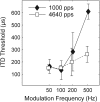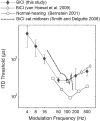Sensitivity of bilateral cochlear implant users to fine-structure and envelope interaural time differences
- PMID: 23556598
- PMCID: PMC3631249
- DOI: 10.1121/1.4794372
Sensitivity of bilateral cochlear implant users to fine-structure and envelope interaural time differences
Abstract
Bilateral cochlear implant users have poor sensitivity to interaural time differences (ITDs) of high-rate pulse trains, which precludes use of these stimuli to convey fine-structure ITD cues. However, previous reports of single-neuron recordings in cats demonstrated good ITD sensitivity to 1000 pulses-per-second (pps) pulses when the pulses were sinusoidally amplitude modulated. The ability of modulation to restore ITD sensitivity to high-rate pulses in humans was tested by measuring ITD thresholds for three conditions: ITD encoded in the modulated carrier pulses alone, in the envelope alone, and in the whole waveform. Five of six subjects were not sensitive to ITD in the 1000-pps carrier, even with modulation. One subject's 1000-pps carrier ITD sensitivity did significantly improve due to modulation. Sensitivity to ITD encoded in the envelope was also measured as a function of modulation frequency, including at frequencies from 4 to 16 Hz where much of the speech envelope's energy and information resides. Sensitivity was best at the modulation frequency of 100 Hz and degraded rapidly outside of a narrow range. These results provide little evidence to support encoding ITD in the carrier of current bilateral processors, and suggest envelope ITD sensitivity is poor for an important segment of the speech modulation spectrum.
Figures







Similar articles
-
Differences in the temporal course of interaural time difference sensitivity between acoustic and electric hearing in amplitude modulated stimuli.J Acoust Soc Am. 2017 Mar;141(3):1862. doi: 10.1121/1.4977014. J Acoust Soc Am. 2017. PMID: 28372072
-
Spatial hearing benefits demonstrated with presentation of acoustic temporal fine structure cues in bilateral cochlear implant listeners.J Acoust Soc Am. 2014 Sep;136(3):1246. doi: 10.1121/1.4892764. J Acoust Soc Am. 2014. PMID: 25190398 Free PMC article.
-
Sensitivity to interaural level and envelope time differences of two bilateral cochlear implant listeners using clinical sound processors.Ear Hear. 2004 Oct;25(5):488-500. doi: 10.1097/01.aud.0000145124.85517.e8. Ear Hear. 2004. PMID: 15599195
-
Perception and coding of interaural time differences with bilateral cochlear implants.Hear Res. 2015 Apr;322:138-50. doi: 10.1016/j.heares.2014.10.004. Epub 2014 Oct 19. Hear Res. 2015. PMID: 25456088 Review.
-
Electroacoustic Stimulation.Otolaryngol Clin North Am. 2019 Apr;52(2):311-322. doi: 10.1016/j.otc.2018.11.008. Epub 2019 Jan 5. Otolaryngol Clin North Am. 2019. PMID: 30617011 Review.
Cited by
-
The effect of envelope modulations on binaural processing.Hear Res. 2019 Aug;379:117-127. doi: 10.1016/j.heares.2019.05.003. Epub 2019 May 21. Hear Res. 2019. PMID: 31154164 Free PMC article.
-
Transmission of Binaural Cues by Bilateral Cochlear Implants: Examining the Impacts of Bilaterally Independent Spectral Peak-Picking, Pulse Timing, and Compression.Trends Hear. 2021 Jan-Dec;25:23312165211030411. doi: 10.1177/23312165211030411. Trends Hear. 2021. PMID: 34293981 Free PMC article.
-
Magnified interaural level differences enhance binaural unmasking in bilateral cochlear implant users.J Acoust Soc Am. 2025 Feb 1;157(2):1045-1056. doi: 10.1121/10.0034869. J Acoust Soc Am. 2025. PMID: 39932277
-
Lateralization of binaural envelope cues measured with a mobile cochlear-implant research processora).J Acoust Soc Am. 2023 Jun 1;153(6):3543-3558. doi: 10.1121/10.0019879. J Acoust Soc Am. 2023. PMID: 37390320 Free PMC article.
-
Sensitivity to interaural envelope correlation changes in bilateral cochlear-implant users.J Acoust Soc Am. 2015 Jan;137(1):335-49. doi: 10.1121/1.4904491. J Acoust Soc Am. 2015. PMID: 25618064 Free PMC article.
References
-
- Blauert, J. (1997). Spatial Hearing (MIT Press, Cambridge, MA: ), pp. 36–200.
Publication types
MeSH terms
Grants and funding
LinkOut - more resources
Full Text Sources
Other Literature Sources
Medical
Miscellaneous

